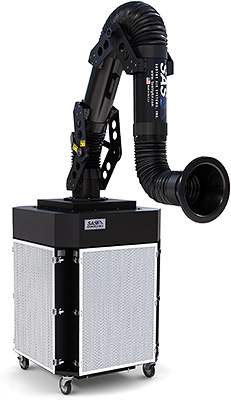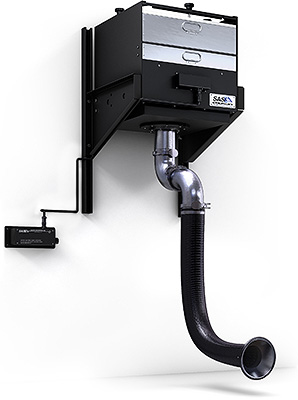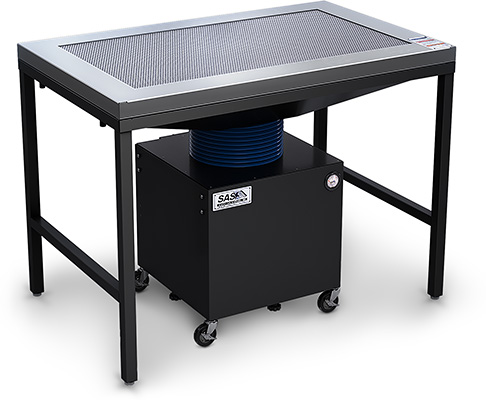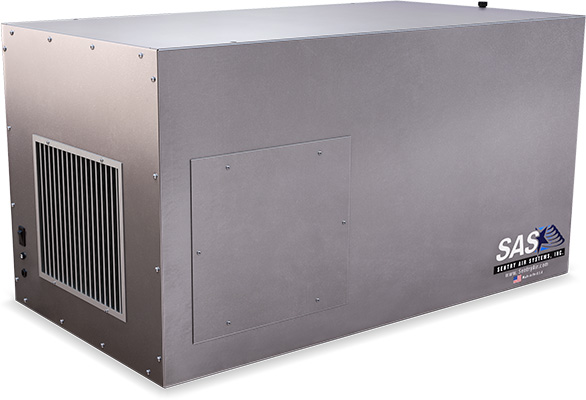Grinding Dust
Grinding dust becomes airborne causing harmful health side effects to operators and nearby employees. Metal grinding dust turns respirable when broken up into particles 5 microns in size. These microscopic sized particles enter and deposit deep within the lungs leading to impaired lung functioning and possible lung disease. Dust produced from other metalworking processes such as polishing, blasting, cutting, and deburring must be controlled to prevent lasting lung conditions. The key to dust control is to capture and isolate the dust before it reaches the breathing zones of the operator or other nearby employees. Grinding dust and other dust particles can spread through a workspace quickly causing damage to nearby workers, machines, and expensive electronic equipment.

Industrial
Sentry Air Systems offers a wide variety of chemical fume extraction equipment for the removal and purification of chemical fumes and vapors to assist in protecting the respiratory zone of those working with hazardous compounds and solutions. Typical applications include solvent-based cleaning or rinsing, formaldehyde, epoxies and resins, plastic bonding and gluing, touch-up painting, melting plastics, acid etching and a variety of applications involving chemical and solvent fumes, vapors, and chemical dusts.

Wall Mounted
The wall mounted fume extractor is a uniquely engineered air filtration system that is built specifically for small or limited workspace environments where air purification is desired. This source capture system features a free-hanging, self-supportive flex arm that can easily be maneuvered by the operator to their desired location.
This fume extractor combines quiet operation, energy-efficient technology, and a unique mounting option that creates an effective solution for many applications that require fume and particulate removal.

Downdraft Table
The Industrial Downdraft Table is a highly effective stainless steel source-capture solution for the extraction of fume, dust, and smoke at the work surface level. This safety engineering control helps to protect the operator’s breathing zone and surrounding environment from hazardous airborne contaminants by creating a negative-pressure and pulling respirable particles into the filtration system.
These negative-pressure systems are designed to eliminate costly exhaust systems, reduce energy losses, and aid in employee protection by capturing pollutants at the source of emission. By utilizing our 400 series fume extraction system, the air cleaner provides up to 700 CFM of air volume and is equipped with high-quality HEPA filtration media that is up to 99.97% efficient on particles 0.3 microns and larger.

Ambient Air Cleaner
Ambient Mist Collectors, or Industrial Mist Collectors, are designed to capture and collect excess mist commonly found in machining and tooling shops. Typical applications include general shop mist collection, open CNC lathes and waterjet machines that produce ambient mist, and other applications that produce oil mist, water mist or coolant mist.
This system is commonly used in conjunction with the source capture mist collectors but can be utilized as the primary filtration unit as well. In particular, these units are ideal for situations where direct mounting is not available or feasible.
Note: Sentry Air System’s grinding dust collectors are meant for maintenance and low-loading applications - they are not for heavy duty and constant use. Also due to the high volatility of certain dust particles, SAS equipment is not meant for aluminum, titanium, rubber dust, or wax-related applications. Please refer to the OSHA standards and guidelines related to combustible dust.
Grinding Dust Collection System
Grinding dust collection systems remove dust to prevent respiratory health effects. Understanding the composition of the material enables the employer to implement a proper dust protection program including dust collection engineering controls. Sentry Air dust collection systems are best suited for light dust collection such as maintenance operations for one to two hours per week or low-loading operations. Our dust collection systems work best for capturing dust containing:
- Beryllium
- Cadmium
- Carbon Steel
- Cobalt
- Cold Rolled Steel
- Copper
- Lead
- Manganese
- Nickel
- Stainless Steel
Source capture dust collectors, including portable, mounted, and downdraft tables, provide the most efficient dust control method. These dust collection systems remove dust particles before entering the operator’s breathing zone. If source capture dust collectors do not suit the application, ambient air protection equipment hangs from the ceiling or mounts on a nearby table to remove dust particles from the airflow. Ambient air dust collection systems used in addition to source capture dust collectors provide added protection to ensure employee health and safety.
Dust Hazards in the Workplace
Dust hazards in the workplace depend on the length of exposure, type of material, and the type of protection equipment. Health effects vary depending on the metal’s composition. For the most part, inhalation of grinding dust or other dust particles causes scar tissue and impairs lung functioning leading to chronic lung disease. Once grinding dust has entered the lungs, dust particles can dissolve in the bloodstream resulting in damage or cancer in vital internal organs. Certain types of grinding dust particles, such as cadmium and stainless steel (hexavalent chromium), exhibit carcinogenic properties leading to lung, prostate, liver, kidney or even brain cancer. Manganese can cause neurological effects or manganism with symptoms similar to Parkinson’s Disease.
OSHA restricts the exposure level of grinding dust to help prevent lasting health effects. The legally restricted exposure limit varies by metal type and can be found on OSHA’s Annotated Table 'Z-1', which is excerpted in the table below. Also, the table summarizes the recommended levels specified by other occupational safety organizations NIOSH and ACGIH. These organizations’ standards are not legally enforced but provide insight into the exposure level recommended to eliminate safety risks as much as possible. Certain dust may not be regulated and fall under OSHA’s respirable dust category with an exposure limit of 5 mg/m3.
OSHA Annotated PELs Table Z-1
Exposure Limit | Exposure Limit | Limit Value | |
|---|---|---|---|
| Beryllium | 0.2 µg/m3 | No Detectable Levels | 0.2 µg/m3 |
| Cadmium | 5 µg/m3 | No Detectable Levels | Total Dust: 10 µg/m3 Respirable 2 µg/m3 |
| Cobalt | 0.1 µg/m3 | 0.05 µg/m3 | 0.02 µg/m3 |
| Copper | 1 µg/m3 | 0.1 µg/m3 | 0.1 µg/m3 |
| Hexavalent Chromium | 5 µg/m3 | 0.2 µg/m3 | 0.2 µg/m3 |
| Lead | 0.05 µg/m3 | 0.05 µg/m3 | 0.05 µg/m3 |
| Manganese | 5 µg/m3 | 1 µg/m3 | 0.02 µg/m3 (Respirable) |
| Nickel | 1 µg/m3 | 0.015 µg/m3 | Elemental: 0.2 µg/m3 Insoluble: 0.2 µg/m3 |
| Other Respirable Dusts | 5 µg/m3 | None | None |
Additionally, the buildup of grinding dust can result in fire and combustion hazards. Even a small layer of dust can combust causing an explosion. Dust protection programs must be developed and implemented to control dust and prevent employee health and safety hazards.

 Made in the USA
Made in the USA